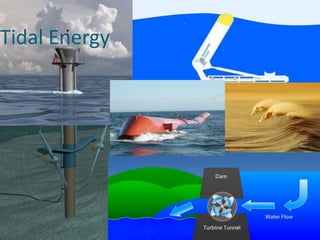Tidal energy harnesses the predictable power of ocean tides and currents to generate electricity through various methods like tidal barrages and tidal turbines. Tidal barrages capture energy by trapping water behind large dams during high tide, then releasing it to spin turbines during low tide. Tidal turbines resemble underwater windmills that spin to generate power from tidal currents. While tidal energy is renewable and predictable, methods like barrages can impact local ecosystems and transportation.



















